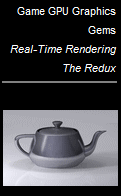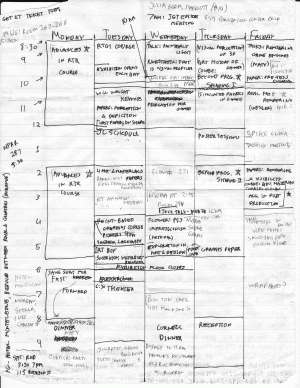Well, let’s see how far I get tonight in clearing the backlog of 219 potential resources I’ve stored up. Here goes:
- NShader – If you use MSVC and you write shaders, this one’s for you. It highlights shader text as you’d expect, highlighting function names correctly and generally making code more readable. Worthwhile, I’ve installed it, it’s fine. That said, you can get 90% of the way there (and for sure 100% virus free) by simply using “Options | Text Editor | File Extension” and setting extension .fx (.fxh, etc.), choosing Microsoft Visual C++, then clicking Add. Do it now.
- Speaking of shaders, I lost much of a day tracking down a bug in Cg: writing code like this, “max(0,someVar);” gave different results than HLSL when someVar was a float. My advice: always use the floating point version of numbers in shaders. So “max(0.0f,someVar);” fixed the problem. Reported to NVIDIA.
- Morgan McGuire pointed out that John Carmack now has a Twitter account. It’s pretty interesting, in that he’s writing a ray tracer in OpenCL and relearning or rederiving various bits of knowledge that are not really written down anywhere. The guy’s unnervingly productive: “Goal for today: implement photon maps and contrast with my current megatexture radiosity gathering.” But what will he do after lunch?
- Speaking of Carmack, you must see the Epic Citadel demo for the iPad. Demo video here. Stunning.
- Speaking of Morgan, his Twitter feed mentioned a number of new resources: a new demo (with complete source) of ambient occlusion volumes at NVIDIA, a demo of sample distribution shadow maps (optimized z partitions for cascading maps) at Intel, and an introduction to DX 11 at Gamasutra. He also points out some entertaining visual bits, like the fascinating style of Devil’s Tuning Fork and a game map scale comparison chart (wow, WoW is small!). Morgan and others’ free multi-platform G3D Innovation Engine is now in release 8.0, and is supposed to be good for students, researchers, and indie game developers.
- Speaking of Intel, they actually have three new DirectX 11 demos with source, as noted in this Geeks3D article.
- Implementing some form of an A-buffer (multiple fragments stored in a pixel) is becoming more common. It’s an algorithm that can perform antialiasing and, more importantly, order-independent transparency. We already mentioned AMD’s efforts using DirectX 11; Cyril Crassin has taken their idea and improved cache coherency a bit, creating an OpenGL 4.0+ version of the linked-list approach, with source.
- I love the idea of driving rendering computations by drawing some simple quad or whatever on the screen and having the pixel shader figure out where, at what depth, and what normal the surface is actually located. The quad is like a bounding volume, the pixel shader essentially a ray caster. Naty sent on this link: the game Hustle Kings uses this technique to great effect for rendering its billiard balls – gorgeous. Video here. Perfect spheres here look lovely. I have to wonder how many triangles in a mesh would be visually identical at closest approach; it seems like the eye is quite good at picking up slight irregularities in tessellated spheres when they are rotating.
- There’s also a pretty displacement mapping demo in OpenGL 4.0 showing GPU tessellation at work.
- I like seeing that 3D printers are becoming still cheaper yet, $1500, and this one looks like a fairly clean system (vs. cornstarch dust everywhere, etc.).
- There’s a basic object/object intersection library now available for XNA, GeometricIntersection.
- Blending Terrain Textures is a nice little article on just that. Lerping bad, thresholding good.
- Valve discusses how it worked with vendors to optimize graphics performance on the Mac.
- NASA provides a fair number of 3D models free to download – 87 models and counting.
- HWiNFO32 is a free utility which provides tons of information about your system. The thing that appeals to me is that it appears to show GPU memory load over time (and I verified the load indeed increased when I ran a game). I hadn’t seen this before, and thought it was essentially impossible for Vista, so this makes me pretty happy. I did just notice that my desktop icons all turned to generic white document icons and are unusable, and this happened some time around when I tried this utility. Hmmm.
- Colors in Cultures infographic – I like the concept, it could have been interesting, but it’s mostly just hard to read in this form. Lots of world maps with the countries colored would have perhaps revealed more. Anyway, there’s their data, for remixing.
Now I’m down to 196 potential resources – good! More later.



